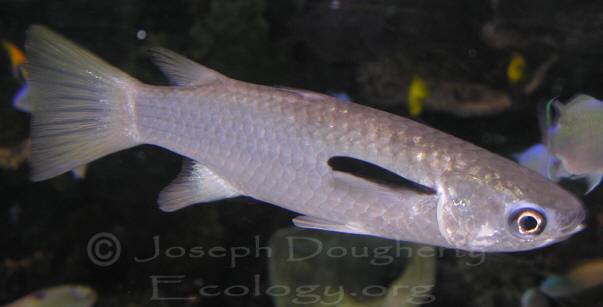Interesting Facts
The squaretail
mullet (Liza vaigiensis) is a member of the grey mullet
(Mugilidae) family. What makes this family of fish interesting is that
it has great value to be farmed and harvested as a source of human food,
due to its collective abilities to grow quickly, eat a wide variety of
food (Wijeyaratne and Costa 1990), and live comfortably in a wide range
of temperatures (James et al. 1985). Furthermore, its ability to be
stocked in brackish water environments makes the the Mugilidae family of
fish an even more desirable choice for large scale human food sources
around the world, in areas where brackish water is the most convenient
environment available (Liao 1975). For this reason, a thriving industry
of aquaculture revolves around the grey mullet (Chen et al. 1999).
Firgure 7.1 Graph of Global Production of Aquaculture presented by country.
Aquaculture is
the controlled farming of organisms found in water, as opposed to the
harvesting of wild fish. It’s like agriculture, but in water instead of
on land. This is an interesting and lucrative business because it allows
aquatic organisms to be grown and harvested for the purposes of food in
a controlled manner, so that demands for seafood can be met without
putting considerable strain on natural populations. Believe it or not,
aquaculture is a massive industry worldwide, with the value of global
net fish exports summing to over 100 billion US dollars in 2008 (World
fish trade 2008). As human populations increase, it is logical to assume
that dependence on aquaculture will increase as well.
Because some
variation of the grey mullet can likely be found in abundance anywhere
around the equator (regions that utilize the grey mullet for aquaculture
include America’s south and the caribbean, the mediterranean, and the
waters of Asia), this means that the grey mullet shall play an
increasingly large role in the feeding of people worldwide. Aquaculture
is growing particularly quickly in and around Asia, where the massive
populations of people demand immense quantities of food. According to
the World Food and Agriculture Organization, aquaculture production in
Malaysia alone doubled its output from 2005 to 2010 (Malaysia
aquaculture 2010). Because the grey mullet family of fish thrives in
Asian waters, the taste of Liza vaigiensis and its relatives are
very likely to be familiar to millions of hungry people. Furthermore, a
plan for American aquaculture output to increase to a projected five
times what it was in the year 2000 is underway (Naylor et al. 2001), so
species of mullet that live in the western hemisphere, particularly the
flathead or striped mullet (Mugil cephalus), are likely to gain
prominence in American culinary culture as well.
In fact, the mullet already has a dedicated following in Florida, where thousands of Mugilidae aficionados come together to cumulatively consume up to four tons of the fish during the three day long annual Niceville Mullet Festival. Mulletfestival.com describes the event, as well as the delicious quality of the fish it celebrates, more eloquently than I ever could, so I encourage you to follow this link!
 Figure
7.2 Battering of mullet filets to feed the hungry people of the
festival.
Figure
7.2 Battering of mullet filets to feed the hungry people of the
festival.
View References
Return Home

